Once upon a time Asian super-sleuths, independent crime-fighters of Chinese or Japanese origin who were usually one or two steps ahead of the police in solving murders, were quite popular in Hollywood. They were, with one notable exception, played by Caucasian actors. There were three distinct characters around whom series of films were created in the 1930s: Charlie Chan, Mr. Moto and Mr. Wong. The Chinese Chan was portrayed by Swedish-born Warner Oland in the 1930s, Sidney Toler in the late ’30s and early 1940s, and Roland Winters in the late ’40s. The Japanese Mr. Moto, an agent working for the International Police, was played by Austro-Hungarian actor Peter Lorre. The Chinese Mr. Wong was played by British actor Boris Karloff. Lorre and the Chan actors played their roles with distinct Asian accents while Karloff played the Oxford-educated Wong with his normal voice. All three characters drew on the stereotype of the exotic, inscrutable Asian sage with depths of knowledge and wisdom derived from ancient traditions. Chan, in particular, was given to issuing frequent fortune cookie-style aphorisms that were often played for laughs. (E.g. “Mind like parachute – only function when open” and “Inconspicuous molehill sometimes more important than conspicuous mountain.”)
Charlie Chan (Warner Oland):
Mr. Wong (Boris Karloff):
Mr. Moto (Peter Lorre):
Recently, I decided to watch MR. MOTO’S LAST WARNING (1939) on Amazon Prime, the first time I’d seen any of the Moto series in decades. Mr. Moto’s first scene in the film made me wonder if I’d entered an alternate universe in which famous Asian detectives in Hollywood films were actually played by Asian actors. When we first meet Mr. Moto on a cruise ship early in the film, he is played by Teru Shimada (pictured below), a Japanese actor who worked in Hollywood before and after World War II. It becomes clear pretty quickly that this character is secretly working with the real Mr. Moto and soon comes into contact with the actual Mr. Moto (Peter Lorre), who passes him a message. So we have the spectacle of a real Japanese actor playing a fake Mr. Moto who then meets the real Mr. Moto played by a fake Japanese actor.
This came a couple of weeks after seeing a movie called THE PRINCESS COMES ACROSS (1936), a romantic comedy set aboard an ocean liner which included a murder mystery subplot in which five detectives from different countries, heading for a conference in New York, work together to solve the mystery. The detectives come from England, France, Germany, Russia and Japan and, with the exception of the French detective, were all played by actors from their respective countries. The Japanese detective, Mr. Kawati, was played by Tetsu Komai (pictured below), a Japanese actor who, like Teru Shimada, worked in Hollywood before and after World War II. (Interestingly, just a few years after this film, all five of the countries represented would become embroiled in the war, with two, England and Russia, at war with two of the others, Germany and Japan, with France occupied by Germany.)
I was reminded of two other films from that era in the mystery/crime genre which actually employed Asian-American actors as crimefighters in the lead roles: DAUGHTER OF SHANGHAI (1937), in which Anna May Wong goes undercover to get the goods on an immigrant smuggling ring and is aided by a Chinese-American FBI contact played by Korean-American actor Philip Ahn; and PHANTOM OF CHINATOWN (1940), in which Chinese-American actor Keye Luke plays a younger version of Karloff’s Mr. Wong and helps the San Francisco police solve the murder of an archaeologist. Luke’s frequent onscreen partner in the film is a Chinese woman (played by Japanese-Hawaiian actress Lotus Long) who was the secretary of the murdered archaeologist and is actually an undercover agent for the Chinese government.
This also came at a time when I was participating in a discussion on the Turner Classic Movies fan group on Facebook about the casting of the two lead roles in THE GOOD EARTH (1937), a tale of struggling farmers in China in which the top six speaking roles all went to white actors. Anna May Wong had lobbied hard to get the lead female role of O-Lan, which wound up going to Luise Rainer, who’d won the Best Actress Oscar for THE GREAT ZIEGFELD a year earlier and would win one again for this film.
What’s also significant about this group of films (and I would include THE GOOD EARTH here), particularly the Charlie Chan films, is the large number of Asian and Asian-American actors who were employed in them. Charlie Chan invariably had a “number one son” working with him, played by Keye Luke (as Lee Chan) in the first wave of Chan films with Warner Oland. Other sons in the hierarchy included Victor Sen Yung (as Jimmy Chan) in the second wave of Chan films, with Sidney Toler as Chan, and Benson Fong (as Tommy Chan) in six of the Toler Chan films. Victor Sen Yung continued into five of the final six Chan films, with Roland Winters as Chan, and Keye Luke returned as Lee Chan in the last two Chan films. In BLACK MAGIC (1944), it was Chan’s daughter, Frances Chan (played by an actress conveniently named Frances Chan), who joined her father for the ride, while his sons took a break. And in THE JADE MASK, Keye Luke’s younger brother, Edwin Luke, played Eddie Chan. Among the other Asian performers popping up in supporting roles in the Chan series were Layne Tom Jr., Philip Ahn, Marianne Quon, Iris Wong, Barbara Jean Wong, and Toshie Mori. (Interestingly, when the first Charlie Chan films were made as silent films in the 1920s, the actors portraying Chan, who was not the lead character in either of the films, were both Japanese.)

Charlie Chan (Warner Oland) with some of his children in a publicity still from 20th Century Fox

Warner Oland, in his Charlie Chan makeup, flanked by Layne Tom Jr. on the left and Keye Luke on the right
The Mr. Wong films also had significant Asian supporting casts. Of the two films I watched for this piece, both on Amazon Prime, MR. WONG IN CHINATOWN (1939) had five Asian actors in support, while THE MYSTERY OF MR. WONG (1939) had four. Lotus Long is in both of them, but gets murdered each time. At least in THE MYSTERY OF MR. WONG, she had a real part and was involved in the drama for a major part of the film. She plays a maid but she comes with a significant backstory that’s important to the plot and her lover and would-be partner-in-crime is a Russian émigré seeking to make it on the concert stage in America.

Lotus Long and Ivan Lebedeff in THE MYSTERY OF MR. WONG
In MR. WONG IN CHINATOWN, Ms. Long plays a Chinese princess and her murder sets the plot into motion. Bessie Loo plays her servant and is soon murdered also. Ms. Loo is worth noting for two reasons. She was the wife of Richard Loo, a major Chinese-American character actor in Hollywood for nearly 50 years and, thanks to her work recruiting Asian extras for THE GOOD EARTH, she became a talent agent for Asian performers in Hollywood and is recalled by Lisa Lu in her audio commentary on the “Bonanza” episode, “Day of the Dragon.” Richard Loo also appears in MR. WONG IN CHINATOWN, as a Tong leader whom Mr. Wong visits in Chinatown. There’s no pay-off to the scene and I suspect it was included simply to justify the film’s title since it’s Wong’s ONLY visit to Chinatown in the course of the film, as far as I could tell. Also, Lee Tung Foo has a recurring role in the series as Mr. Wong’s domestic manservant. He occasionally speaks in Cantonese.

Philip Ahn, Pauline Frederick, Peter Lorre in THANK YOU, MR. MOTO
The Mr. Moto series had fewer Asian performers, but there were a handful worth noting. Philip Ahn plays Prince Chung in THANK YOU, MR. MOTO (1937), although a white actress, Pauline Frederick, plays his mother, Madame Chung. Lotus Long appears in the first Mr. Moto film, THINK FAST, MR. MOTO (1937), and again in MYSTERIOUS MR. MOTO (1938) where she is curiously billed as Karen Sorrell. (Her birth name was Lotus Pearl Shibata.) Keye Luke appears as Lee Chan, Charlie Chan’s son, in MR. MOTO’S GAMBLE (1938), which had originated as a Charlie Chan film but been reworked as a Mr. Moto vehicle after the death of Warner Oland, with Lee Chan staying on as a criminology student of Mr. Moto’s. And, of course, there’s the aforementioned MR. MOTO’S LAST WARNING (1939), with Teru Shimada as the fake Mr. Moto.

Keye Luke, Harold Huber, Peter Lorre in MR. MOTO’S GAMBLE
PHANTOM OF CHINATOWN, the only Mr. Wong film not to star Karloff, deserves more discussion because of the way the dynamics of racial interaction shift when the lead character, Mr. Wong, is played by an Asian actor (Keye Luke) and portrayed as much younger than the supporting white characters. In the Boris Karloff Wong films, James Lee Wong was a revered scholar and someone with a long history of aiding the local police in their investigations. He is treated with deference and respect throughout, even by the gruff police detective leading the various investigations, Captain Street (Grant Withers). In PHANTOM OF CHINATOWN, Jimmy Wong, as he’s now called, is new to the game and is meeting Captain Street for the first time, identifying himself only as a “researcher” and a former student of the murdered archaeologist, Dr. John Benton (Charles Miller). Street is quite brusque with Wong at first and the police even make some insensitive remarks around the Chinese characters. When Street is questioning the murder victim’s butler about the food served in the household preceding the death by poison, he points to the archaeologist’s Chinese secretary and asks, in quite a demeaning fashion, “What’d SHE eat? Chop suey?!” Later, after Wong has been knocked out by an interloper during the investigation, Street’s assistant says, “Out like a red lantern.”

Lotus Long, Keye Luke, Grant Withers in PHANTOM OF CHINATOWN
However, as the investigation continues, Street gradually warms up to Wong and swallows his pride to ask him for help, knowing that his specialized knowledge will come in handy and the two develop a friendly rapport. Luke plays the role in such a way that we know he’s irritated by the way he’s treated but goes along with it to get the job done. At one point, in response to a report of the archaeologist’s discovery and opening of the Emperor’s tomb in China, he makes a crack about Chinese archaeologists coming to the U.S. to dig up George Washington’s grave. It’s a throwaway line, but it packs a punch and reveals some simmering discontent with the way Europeans and Americans view ancient cultures as a source of treasure.

Keye Luke, Lotus Long in PHANTOM OF CHINATOWN
Lotus Long plays Win Len, Dr. Benton’s secretary, and she’s a major participant in the investigation of the murder, with Street even tagging her as a suspect at different points in the narrative. We eventually learn that Win Len is an agent of the Chinese government trying to retrieve the scroll that was taken from the tomb because it contains a great secret that would greatly aid China’s defense or, if it fell into the wrong hands, benefit the unnamed forces at war with China at the time (Japan). (A reference is made in THE MYSTERY OF MR. WONG to “the looting of Nanking,” although no mention is made of exactly who did the looting.) A possible romance between Wong and Win Len is hinted at but never really developed. It may be the biggest part Lotus Long ever had and I can only lament that the attractive, strong-featured actress was not better at her job. Her line delivery is stiff throughout and I suspect it was because this was such a low-budget production, shot in a matter of days, and she’d never had to carry a role like this before. She was much better as the more temperamental maid Drina in THE MYSTERY OF MR. WONG, where she had fewer scenes. Keye Luke, on the other hand, had 27 films to his credit by this point, many of them shot quickly and cheaply, and he’d mastered the game quite well.
We see glimpses of San Francisco’s Chinatown and its insular Chinese community in PHANTOM OF CHINATOWN, as when the lead characters visit the Chinatown Telephone Exchange, which is staffed entirely by Chinese women (pictured above). Street and Wong later investigate a Chinese restaurant and its proprietor, played by Victor Wong, whom they suspect operates the restaurant as a front for some criminal activity. It’s in this scene that we learn that Wong carries a gun, something I don’t believe Karloff’s Wong ever did. He doesn’t shoot anybody but uses it to shoot open a lock leading to a hidden chamber in the back of the Chinese restaurant.
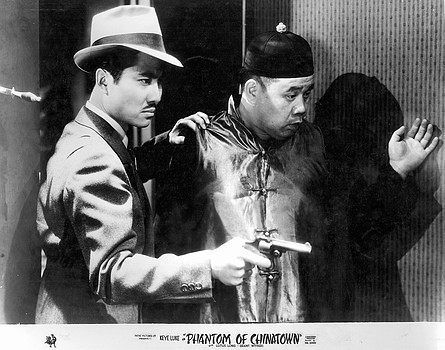
Keye Luke, Victor Wong in PHANTOM OF CHINATOWN
The same year Luke starred in PHANTOM OF CHINATOWN, he also appeared as Kato in the first serial version of THE GREEN HORNET. Kato was not only chauffeur to the title character, but also his partner-in-action and the inventor of the elaborate weapons and gadgets that the Green Hornet used in his investigations and battles with criminal opponents. He’s another proactive Asian crimefighter from this period and also played by an Asian actor.
The role of Kato would, of course, become much more famous in 1966 when Bruce Lee played the role in the TV series, “The Green Hornet,” and first displayed his kung fu skills to the world.
DAUGHTER OF SHANGHAI shifts the dynamic even further. It features two Asian protagonists at the heart of an investigation, one female and one male, both played by Asian-American actors. Anna May Wong plays Lan Ying Lin, the well-to-do daughter of a San Francisco-based importer of Chinese art and Philip Ahn plays “G-man” Kim Lee, a federal agent investigating the wholesale smuggling of illegal immigrants into the U.S. from China and other places. (In real life, Wong and Ahn had been schoolmates as children in Los Angeles). A newspaper article about Lee identifies his agency as the U.S. Bureau of Investigation, presumably to let the FBI off the hook in case any curious Hollywood reporter sought to find out if there were, in fact, any Asian-American agents in the FBI at the time. While Kim Lee is an agent for the government, Lan Ying acts in an unofficial capacity, so one can argue that she is playing a role similar to that played by Mr. Wong in his series of films, where the character was a private citizen whose help is sought to solve a case. Here, however, Lan Ying acts entirely on her own initiative and informs no one so that her cover won’t be blown when she travels to a Caribbean island to seek out the highest known figure in the smuggling ring. Her chief motive is justice for her father who was murdered by henchmen working for the smugglers after he’d refused to employ any of the aliens. Interestingly, all the villains are white and most of the white people whom Lan Ying interacts with are involved in the villainy, including a wealthy society woman and art patron who has befriended her. There is one imposing black character who works as a bodyguard for Lan Ying and her father and he is played by Ernest Whitman.
While Lan Ying is working undercover as a dancer in a club run by Hartman (Charles Bickford), who manages the actual smuggling for a secretive higher-up, Lee has gone undercover as a ship’s mate on the cargo ship slated to bring in aliens who’ve paid Hartman for entrance into the U.S. Lee is stunned to encounter Lang Yin there and after reprimanding her for going off on her own, the two join forces to get the needed evidence and bring it back to San Francisco. They are discovered and captured multiple times and have more than a few narrow escapes in a series of suspenseful action sequences in the second half of this 62-minute film. The two stars fully participate in the action from start to finish with Ahn getting into several fist fights with the bad guys, including the formidable trio of Anthony Quinn, J. Carrol Naish and Buster Crabbe! Ms. Wong doesn’t fight, but shows great courage in going undercover amidst such hardcases, surely something the character’s privileged upbringing might not have prepared her for. She even dresses as a man to board the smuggling ship so she can get back to San Francisco, but is put in great danger when she is discovered to be a woman by the desperate souls below deck. At the end of the film, Lan Ying and Lee share a moment in the back seat of a car, with one asking the other to marry him and the two speaking their final lines in Cantonese.
How did a film like DAUGHTER OF SHANGHAI, with two heroic Asian leads, get made by a Hollywood studio (Paramount) in 1937? Well, it was a B-movie, shot quickly on a low budget by a director (Robert Florey) who knew how to inject quality into such productions, which meant that less was riding on it and the studio could afford to take risks. Besides, they had Anna May Wong under contract and the actress had recently gained a lot of publicity for taking a long trip to China, so creating a starring role for her with this title seemed like a good way to capitalize. (“Daughter of Shanghai” is the way Wong’s character is billed when she performs her dance act in the Caribbean nightclub while working undercover.)
As mentioned earlier, Wong had lobbied hard for the lead role of O-Lan in MGM’s THE GOOD EARTH, which came out the same year, but had seen it go to a white actress. MGM had offered her another role in the film, but she’d turned it down. Truth to tell, it seems highly unlikely that MGM would embark on a big-budget drama based on a best-selling novel without proven stars. The stars, Paul Muni and Luise Rainer, had won Best Actor and Best Actress Oscars the year before and were prestigious, high-profile performers at the time. Muni was well-known for playing different ethnicities, so it was not a stretch for audiences and critics to see him in the role of a Chinese farmer. There was also no organized protest activity about such casting the way there would be in later decades. It was simply the way things were done.

Paul Muni, Walter Connolly in THE GOOD EARTH

Luise Rainer in THE GOOD EARTH
At least there were Asian actors in at least 25 other speaking parts in the film, including Keye Luke, Philip Ahn, Richard Loo and Victor Sen Yung, not to mention Loo’s wife, Bessie Loo, who, as mentioned above, would use this film as the impetus to start a talent agency specializing in Asian performers in Hollywood.

Richard Loo is visible standing behind Paul Muni in THE GOOD EARTH

Roland Lui, Keye Luke and Luise Rainer in THE GOOD EARTH
Anna May Wong made other B-movies at Paramount, including DANGEROUS TO KNOW, KING OF CHINATOWN (pictured above), and ISLAND OF LOST MEN, but I’ve never had a chance to see these films, so I don’t know what her characters were like. I have seen the two war-themed B-movies she made in 1942, BOMBS OVER BURMA and LADY FROM CHUNGKING (pictured below), and can report that she’s the lead character in both films, playing Chinese patriots resisting the Japanese. She’s tough, no-nonsense and straightforward in both films, without a trace of “exotic” trappings, and I believe these portrayals are as close as we ever got to the real Anna May Wong on screen.
On a side note, while Buster Crabbe may have a fist fight or two with Philip Ahn in DAUGHTER OF SHANGHAI, just two years later Crabbe would be starring as the title character in Universal’s BUCK ROGERS, where his Saturnian ally, Prince Tallen, was played by none other than Philson Ahn, Philip’s brother.

Philson Ahn, Buster Crabbe, Jackie Moran in BUCK ROGERS
In another serial, G-MEN VS. THE BLACK DRAGON (1943), one of the two lead G-men is a Chinese-American agent named Chang Sing, played by Chinese-American actor Roland Got, who, billed as Roland Lui, had played a supporting role in THE GOOD EARTH. Got is in every episode of the serial and just about every fight scene as he and Rod Cameron (as agent Rex Bennett) take on Japanese spies trying to sabotage the U.S. war effort. So add him to the list of Asian crimefighters played by actual Asian actors in Hollywood films from this period.
After the war, it wasn’t until 1959 that we saw another Asian-American crimefighter played by an Asian-American actor, Detective Joe Kojaku of the Los Angeles Police Department, played by Japanese-American actor James Shigeta in Samuel Fuller’s THE CRIMSON KIMONO (1959). Detective Kojaku and his white partner, played by Glenn Corbett, compete for the affections of a woman they meet in the course of a homicide investigation. In an interesting twist, the Japanese guy gets the (white) girl. You can see what kind of novelty that was by this poster for the film:

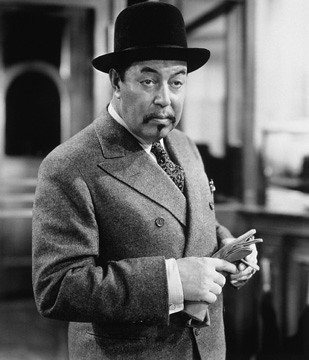
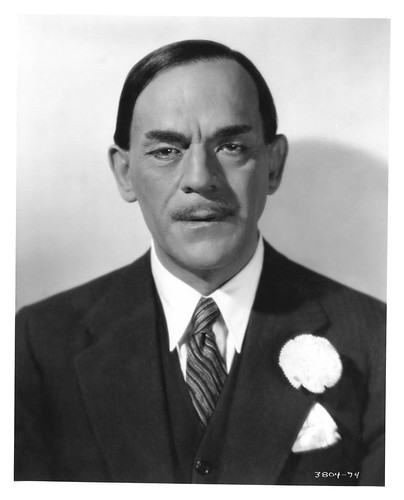

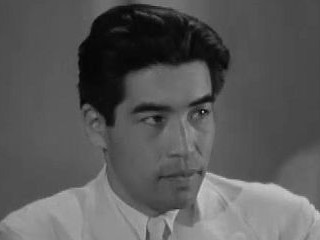



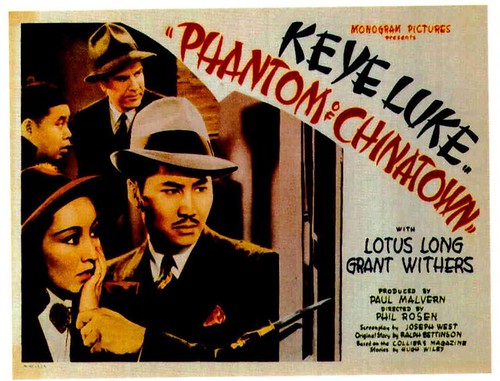
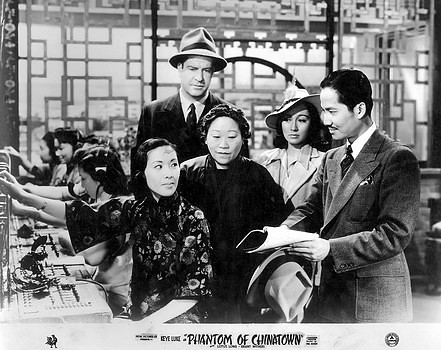
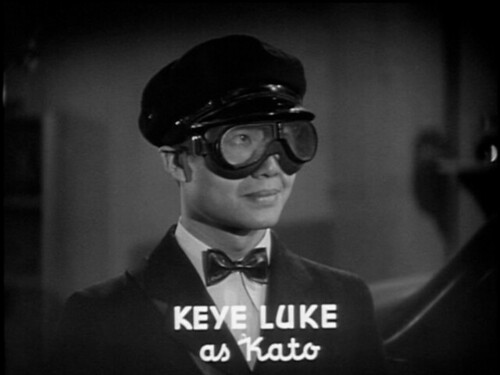

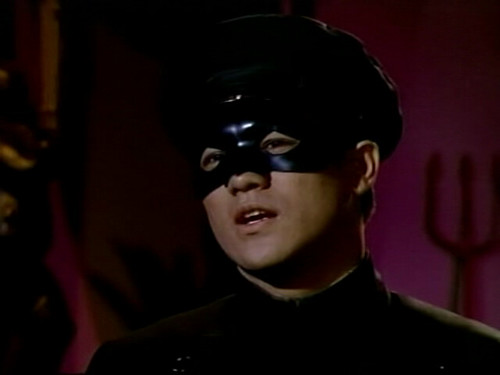
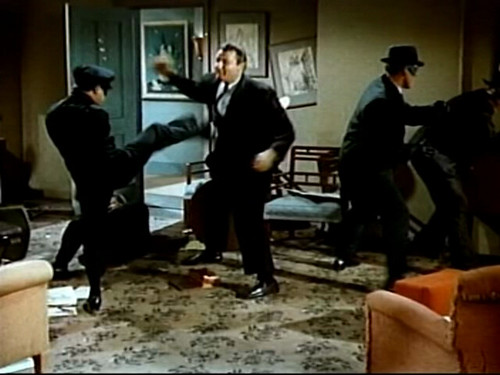
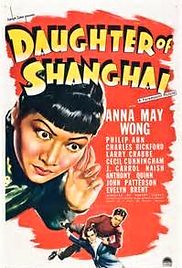

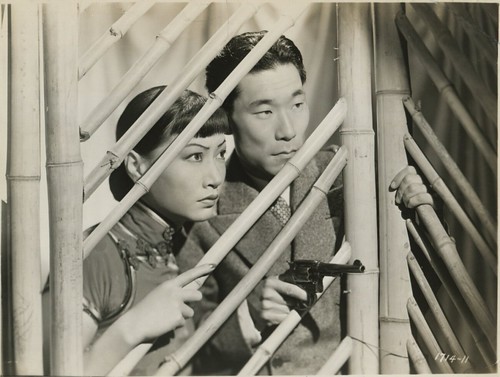

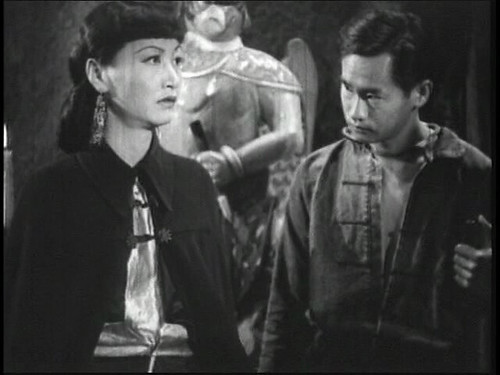
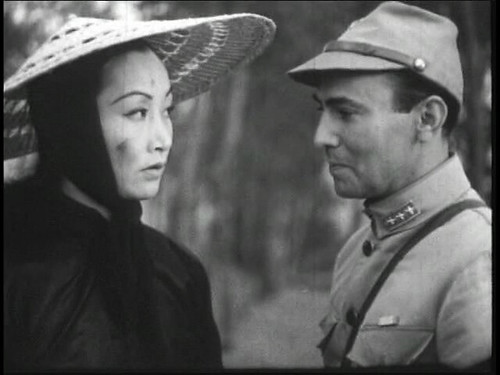

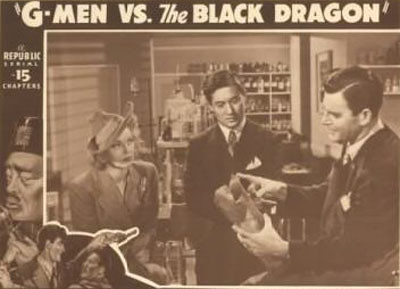
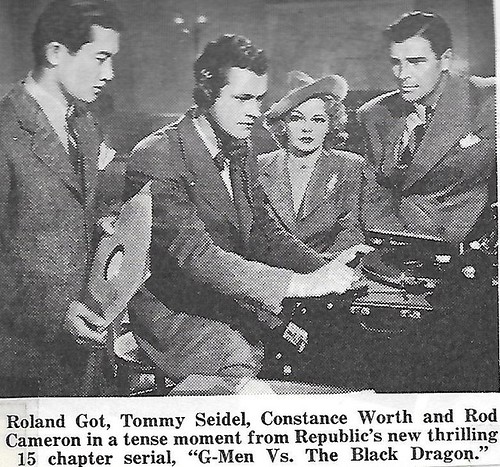
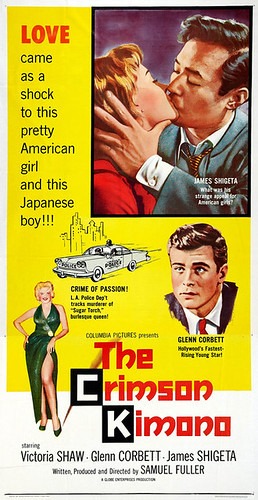
Very informative! Thanks, Brian!
You know it’s ironic, if I had to cast an actual Japanese person at the time as Mr. Moto, at least by appearance, I would pick Teru Shimada.